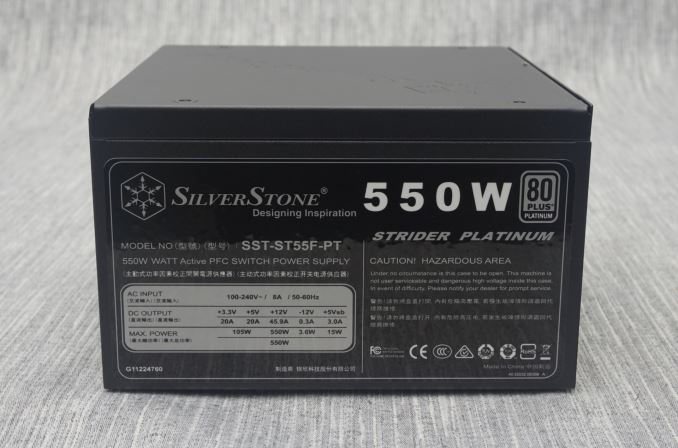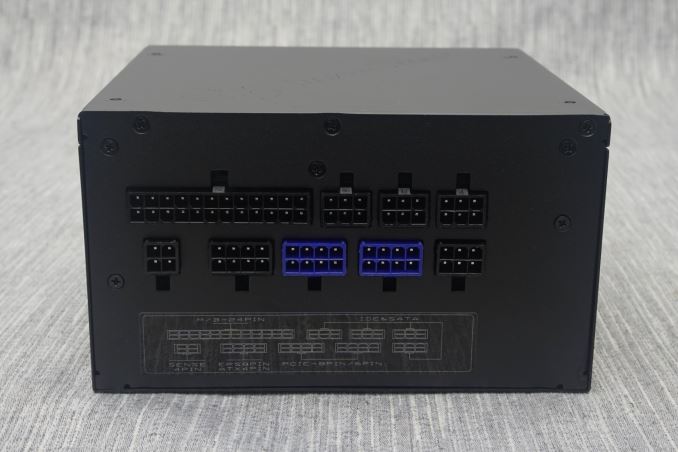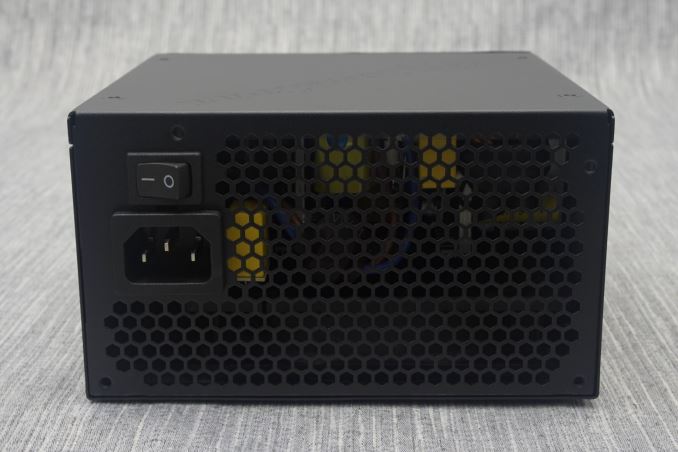The SilverStone Strider Platinum 550W PSU Review
by E. Fylladitakis on April 8, 2016 8:00 AM EST- Posted in
- PSUs
- Cases/Cooling/PSUs
- 550W
- SilverStone
- 80Plus Platinum
External Appearance
Strictly speaking, the external design of the Strider Platinum is unsophisticated. SilverStone went with a minimalistic design, steering away from fancy side stickers and eye-catching colors. The chassis of the PSU is sprayed with a satin black paint, which is excellently applied and highly resistant to smears and fingerprint marks. Due to its reduced length, SilverStone is forced to use a 120 mm cooling fan that is placed offset towards the left side of the unit.
SilverStone placed the sticker with the electrical specifications and certifications of the PSU on the left side of the chassis, making it visible from a windowed side panel if the PSU is installed with its fan facing downwards. The right side of the chassis is entirely plain. SilverStone engraved their company logo on the top side of the chassis, but the engraving is very subtle and most likely will not be easily visible inside a case, even if there is strong illumination.
The rear of the Strider Platinum is very simple, with only the AC cable receptacle and a small on/off switch to be found. Nine connectors for the eight modular cables can be found at the front side of the PSU. The blue connectors are for PCI Express cables and SilverStone is using them to differentiate from the similar CPU EPS connector, which is black. The connectors are keyed, meaning that you cannot really push a PCI Express cable into the EPS connector and vice versa, unless a lot of force becomes involved. Finally, sole 4-pin connector is not a power connector at all, but rather is the connector for the PSU's voltage sense feature, which allows the PSU to monitor the voltages on the 24-pin ATX cable and is supposed to improve the power quality of the PSU.
Internal Design
Globe supplies the 120 mm fan for the cooling needs of the PSU. The 120 mm fan is a high quality model with an FDB (fluid dynamic bearing) engine and, with a maximum speed of just 2000 RPM, actually is the least powerful between Globe’s similar offerings, hinting that SilverStone has great faith on the efficiency of their product.
The OEM behind the creation of the Strider Platinum is Sirfa, with the PSU based on an upgraded version of the Astro Lite HPM platform. It is not a complex design and Sirfa originally used it to achieve 80Plus Gold efficiency, but apparently SilverStone managed to squeeze even better performance out of it. The input filtering stage consists of four Y capacitors, two X capacitors, two filtering inductors and one surge-suppressing MOV, ending to a single input conversion bridge that can be seen on its own small heatsink. The passive APFC components are a 400V/390μF capacitor supplied by Nippon Chemi-Con and a shielded inductor. The primary inversion stage is a half-bridge design and the main transformer has a single 12V output.
On the secondary, the DC to DC conversion circuits used to generate the minor voltage lines can be seen on their own vertical PCB. Thick wires are being used to connect the main PCB with the connector’s PCB, creating a little bit of a mess. Nippon Chemi-Con supplies all of the electrolytic and a couple of the polymer capacitors, with the rest of the polymer capacitors coming from Teapo. One thing of note is that three temperature sensors can be seen attached on the secondary side heatsink, which is inexplicable for a PSU without exotic functions, as the designer could probably pull off all of the functions of the Strider Platinum by using just one.





















27 Comments
View All Comments
ImSpartacus - Friday, April 8, 2016 - link
Always awesome to see a psu review for a psu that I might actually consider.I also like the commentary about the rarity of low wattage platinum power supplies. I hasn't thought about it from that perspective.
close - Friday, April 8, 2016 - link
I guess people with "low power" systems rarely want to invest the extra money in better efficiency at that price level. This bring diminishing returns the smaller the PSU wattage is meaning you pay the same "extra" for the efficiency but get smaller benefits than you would on a 700+W PSU.close - Friday, April 8, 2016 - link
*on the first line it should read "at that power level", not price.ImSpartacus - Friday, April 8, 2016 - link
Yeah, I can definitely understand why that's the case. It's a reasonable perspective.Though, I don't know if I'd consider a 500W pc to be "low wattage." That's realistically all most single gpu gaming rigs ever need.
Murloc - Saturday, April 9, 2016 - link
low wattage as in the difference in efficiency is negligible from a power bill point of view, or actually a minus if you consider higher cost.Daniel Egger - Saturday, April 9, 2016 - link
Where I live you're typically pay 2€ per year per Watt consumed 27/4 (tendency rising). That can add up very quickly; my first home server used a total of 115W sustained, the successor was down to 65W, the next successor was down to 54W initially and then further tweaked down to 40W. That's a hell lot of money saved per year...close - Monday, April 11, 2016 - link
That's exactly what I meant by low wattage. When you have a sub-500W system the savings in economy are rarely recovered via increased efficiency. You need a higher difference from efficiency and to run the system 24/7 to get real benefits. Otherwise you just move the costs from really small installments every month for a few years into a bigger chunk payed at the purchase of the PSU.Namisecond - Monday, April 11, 2016 - link
Actually, you need to look at the efficiency curve. Most power supplies hit their highest efficiency at between 40-75% utilization. Unless you've got a monster gaming rig with dual or more SLI/Crossfire GPUs, you're not going to be in that zone with a 1200-1500W PSU.A single moderate (GTX970/980) GPU system with a quad core processor will probably hit about 300-350W while gaming. About where you want to be with a 500-600W PSU.
random2 - Wednesday, April 20, 2016 - link
Wattage aint everything. Many cheaper PSUs don't have the amps on the 12 volt rail necessary to push major GPUs.random2 - Wednesday, April 20, 2016 - link
Not to mention the 46 amps on the 12v rail. :)